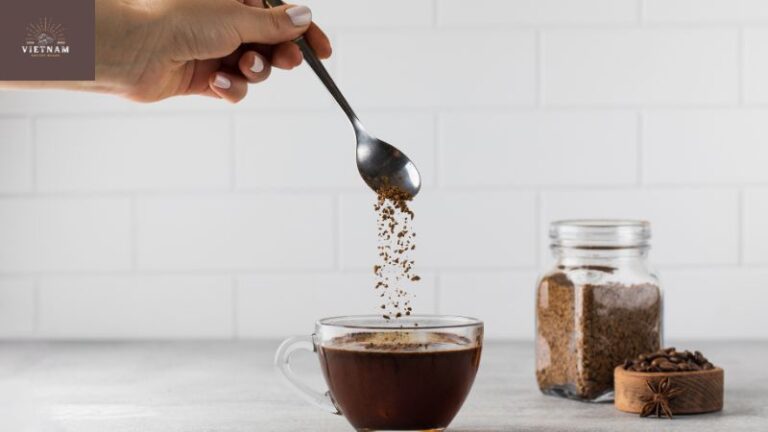Starting and operating your own coffee roasting business from home can be an incredibly rewarding endeavor for any aspiring coffee entrepreneur. As someone with years of experience in the coffee industry, I’ve seen firsthand how a passion for quality coffee can be transformed into a successful small business with the right planning and execution.
In this comprehensive guide, I’ll walk you through the entire process of Starting A Coffee Roasting Business From Home. From writing a rock-solid business plan to choosing the perfect roaster and sourcing high-quality green beans, I’ll provide actionable steps to turn your coffee roasting dreams into reality.
Let’s get brewing with vietnamcoffeebeans!
Key Takeaways of Starting A Coffee Roasting Business From Home
- Conduct thorough market research to identify your target customers and competition. Your business plan depends on it.
- Invest in a high-quality coffee roaster that suits your production goals and budget. This is a make-or-break purchase.
- Experiment with different grains and roasting profiles until you craft that signature flavor profile. This is where you really get to flex your inner coffee crafter.
- Focus on scalable packaging, labeling, and marketing so you can grow from small batches to full-scale distribution.
- Consistency and quality are king. Customers will respond to your passion for roasting the best coffee grains possible.
Write A Strategic Business Plan
The first step to starting a coffee roasting business is writing a comprehensive business plan. This allows you to define your goals for the business, conduct crucial market research, and evaluate the financial feasibility of your new coffee roasting endeavor like The Roasting Plant Coffee.

You’ll want to address the following areas in your written plan:
Goals and Objectives
- What do you want to ultimately achieve with your new coffee roasting business?
- Establish both quantitative goals like sales and profits, and qualitative goals like customer satisfaction rates.
- Outline the objectives and milestones needed to reach those overarching goals.
Market Research
- Who are your target customers and what are their demographics? Surveys and focus groups can provide insight.
- Analyze the competitive landscape. How are other local coffee roasters positioning themselves?
- Identify opportunities to differentiate yourself and meet unmet consumer needs with your offerings.
Financial Plan
- Forecast startup costs like roasting equipment, packaging supplies, brand design, etc.
- Estimate ongoing monthly expenses like rent, utilities, staffing, insurance, etc.
- Project sales revenue based on expected customer demand and growth.
- Determine pricing for your coffee bean products.
- Calculate break-even points and create profit/loss projections.
Here is a table of market research questions for coffee drinkers:
| Market Research Question | Goal |
| Where do local coffee drinkers currently purchase beans? | To understand where coffee drinkers are currently buying their beans, and what factors influence their purchasing decisions. |
| What do they like and dislike about current offerings? | To identify areas where current coffee offerings can be improved. |
| How often do they purchase grains per month? | To understand how frequently coffee drinkers purchase beans, and how much coffee they consume on average. |
| How much do they spend on grains per month? | To understand the average amount of money that coffee drinkers spend on grains each month. |
| What coffee flavors and roast styles do they prefer? | To identify the most popular coffee flavors and toast styles among coffee drinkers. |
Solid market research, realistic financial projections, and clear business goals are the foundation for building a successful coffee roasting business from home.
Source High-Quality Green Coffee Beans
Once you have your business plan squared away, it’s time to start sourcing green coffee grains in preparation for roasting. Locating suppliers of green coffee beans for roasting is paramount for crafting delicious coffee. Here are some best practices for procuring grains as a startup roaster:
- Establish relationships with importers, brokers, and farmers to gain access to sought-after bean varieties like Ethiopian Yirgacheffes and Sumatran Mandheling.
- Sample different grains before buying in bulk to determine flavor profiles. Order 5-10 lb samples of grains you’re interested in.
- Consider sustainability and ethics of bean producers. Support fair trade and organic farming practices when possible.
- Order enough to test roasting but don’t overbuy grains you can’t sell. Green grains last 6-12 months when stored properly.
- Inspect grains carefully upon arrival for defects, consistency, moisture level, and aroma. Reject defective batches.
- Store green grains in breathable burlap sacks or food-grade buckets. Keep grains between 50°F – 80°F out of direct sunlight.
No matter which specific grains you choose to roast, be sure to start with the highest quality green coffee grains you can source. This is what sets specialty roasters apart from commodity coffee. Your connections with farmers and commitment to quality will shine through in the final product.

Invest In A Commercial Coffee Roaster
Owning a professional coffee roaster designed for commercial use is a must when starting a coffee roasting business. Here are some factors to consider when selecting your roasting workhorse:
- Batch size – Choose a roaster that allows you to toast 5-50 lbs at a time depending on your current and future production goals. Start small but have room to scale up.
- Roast styles – Make sure the roaster can achieve different toast profiles from light to dark. You want the versatility to experiment.
- Consistency – Look for even and precise heat controls. Drum roasters tend to offer the most consistency.
- Maintenance – Prioritize easy-to-clean roasters that are built to withstand heavy usage over years.
- Budget – Plan to invest $3,000 – $30,000+ on a commercial roaster depending on capacity and features.
- Training – Opt for turnkey packages that include training so you learn to expertly operate the roaster.
While an entry-level 1-3 lb sample roaster may work initially, you’ll soon need a machine with far greater capacity to grow your coffee roasting business from home. My recommendation is to purchase the largest drum roaster you can afford and operate based on your start-up bean volumes. This allows room to expand without having to purchase a whole new machine.
Master The Art Of Roasting Coffee Beans
Here comes the fun part – it’s finally time to start roasting coffee beans! While the roasting process may seem simple on the surface, there is both art and science involved in coaxing the very best flavors out of green coffee beans.
Follow this process for roasting up perfection:
- Preheat the roaster 30-45 minutes prior to your toast batch. You want an even, hot surface.
- Weigh out grains and track starting weight. This allows you to compare different batches.
- Load grains and keep them moving for even roasting. Corner pockets can lead to scorching.
- Listen for first crack around 8 minutes in signaling the beginnings of toast flavor development.
- Monitor bean temperature and adjust heat controls to follow your target toast profile.
- Reach second crack around 12 minutes for medium roasts. This produces darker, oilier beans.
- Drop the batch into the cooling tray before you hit your target toast level. Beans will continue roasting for a bit after being unloaded.
- Record details like time, temperature, taste notes, and adjustments needed. Repeat and refine.
- Learn the art of examining the impact of roasting on coffee pesticides and understanding coffee roasting flaws
You’ll want to experiment with different toast styles from light cinnamon to dark espresso to determine which profiles complement your grains the best. Blending grains is also an art that takes refinement through many small batch tests. This hands-on work is where you’ll hone your palette and skills as a coffee roaster.
Package, Label, And Sell Your Roasted Coffee
With a stockpile of freshly roasted coffee grains on hand, it’s time to get your product packaged, branded, and ready for sale. You’ll want to focus on the following areas:
Packaging
- Use bags that maintain freshness like resealable, opaque metalized bags fitted with degassing valves.
- Make sure packaging keeps oxygen out and aroma in.
- Explore compostable and reusable options as sustainable alternatives to plastic bags.
Labeling
- Include legally required info like net weight, your business address, and allergen warnings.
- Feature your brand logo and stylized design for shelf appeal.
- List roast date, origin, varietal, tasting notes, and brew method recommendations.
Marketing
- Build an online presence with a user-friendly website, email newsletter, and social media channels. Offer promotions and share content to drive traffic.
- Network with local cafes and shops that may be interested in sourcing your grains for retail or wholesale.
- Set up at coffee festivals, farmers markets, and pop-up events to get the word out and attract new customers.
Sales Channels
- Sell grains online through your website and utilize e-commerce marketplaces like Amazon.
- Offer delivery subscriptions and coffee club memberships for recurring orders.
- Partner with local retailers to get your bags on shelves across town.
- Open a small retail space to sell directly to customers if possible.
The goal is to make your packaging stand out on the shelf while providing all the relevant product information coffee lovers look for. Combined with marketing that spreads awareness and sales channels that meet customer buying preferences, you’re primed for success selling your roasted coffee.

Frequently Asked Questions
In Conclusion
Starting a coffee roasting business at home allows you to share your passion for the craft with other enthusiastic coffee lovers. Follow the steps above to plan your business, purchase equipment, source quality beans, hone your roasting technique, and launch your brand. It takes dedication and hard work, but the reward of doing what you love is worth the effort.
Wake up and smell the coffee – you got this!





